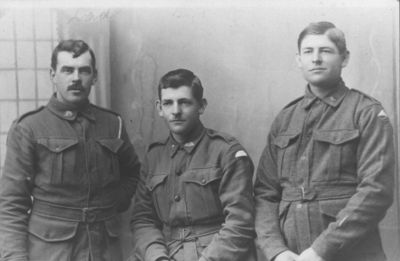Difference between revisions of "Albert Helliwell"
From Our Contribution
| (3 intermediate revisions by the same user not shown) | |||
| Line 1: | Line 1: | ||
{{infobox soldier | {{infobox soldier | ||
| − | | image =[[File:Abercromby_R_Helliwell_A_Helliwell_R_Helliwell.jpg]] | + | | image =[[File:Abercromby_R_Helliwell_A_Helliwell_R_Helliwell.jpg|border|400px]] |
| − | | caption = Albert Halliwell (centre) | + | | caption = Albert Halliwell (centre) N Browning |
| image2 = | | image2 = | ||
| caption2 = | | caption2 = | ||
Latest revision as of 22:18, 26 October 2021
 Albert Halliwell (centre) N Browning | |
| Personal Information | |
|---|---|
| Date of Birth | 16 Feb 1896 |
| Place of Birth | North Fremantle, Western Australia |
| Death | 19 Nov 1960 |
| Place of Death | Croydon, Victoria |
| Age at Enlistment | 20 years, 8 months |
| Description |
5'6" (1.68m) tall tall ; 138lbs 62.596 kg ; fresh complexion ; brown eyes ; light brown hair |
| Occupation | Boat builder |
| Religion | Salvation Army |
| Address | Fremantle, Western Australia |
| Next of Kin | Father , Mr Isaac Helliwell |
| Military Information | |
| Reg Number | 2661 |
| Date of Enlistment | 6 Sep 1916 |
| Rank | Private |
| Unit/Formation | 44th Battalion, 5th Reinforcement |
| Date of Embarkation | 9 Nov 1916 ‒ 10 Jan 1917 |
| Ship Embarked On | HMAT A8 Argyllshire |
| Date of Return | 9 Dec 1918 ‒ 15 Jan 1919 |
| Ship Returned On | SS Leicestershire |
| Fate |
WIA 20 Apr 1917 Ploegsteert Wood Returned to Australia |
| Monument |
Gosnells Road Board Honour Roll Gosnells Ward Honour Roll |
| Medals |
British War Medal Victory Medal |
Pre War
War Service
Entered Blackboy Hill camp on 11 Sep 1916 and almost immediately he was allocated to the 7th reinforcement draft for the 48th Battalion. However, six days later, on 20 Sep 1916 this changed to the 5th reinforcement draft for the 44th Battalion. Two months later he travelled with them to England, where on arrival they were sent to the 11th Training Battalion at Durrington to prepare for France.
On 10 Jan 1917 Albert proceeded overseas to France through Folkestone, and on 13 Apr 1917 he was taken on strength by the 44th Battalion at the Catacombs near Ploegsteert. One week later, on 20 Apr 1917 Albert was wounded in action when the battalion moved into Ploegsteert Wood relieving the 43rd Battalion. The unit War Diary records two (2) casualties (wounded) that day due to shell fire.
Treated by the 9th Australian Field Ambulance for shrapnel wounds to his left arm, right thigh and knee, he was passed back to the 2nd Australian Casualty Clearing Station on the same day. Two days later on 22 Apr 1917 Albert was transferred by Ambulance Train to the 2nd Australian General Hospital in Wimereux, and on 24 Apr 1917 he boarded HMHS St Andrew in Boulogne for England where he was admitted to the Middlesex County War Hospital on 25 Apr 1917.
Recovered, he was granted furlough from 15 - 30 May 1917 wit instructions to report to the Training Depot at Hurdcott, where on 31 May 1917 he was reclassified B1A3. Reclassified five more times between 1 Jun 1917 and 1 Jan 1918, when he was placed on the permanent cadre staff of No.3 Command Depot.
On 27 May 1918 Albert was admitted to 1st Australian Dermatological Hospital at Bulford with Urethritis, and received treatment until 1 Jun 1918. On 12 Sep 1918 Albert was transferred from Sutton Veny to Hurdcott to prepare for his early return to Australia on the grounds of deafness. Discharged by the 5th Military District on 15 Feb 1919.
Post War
During 1932 Albert married Emma Louisa Hollingworth in Victoria.
Notes